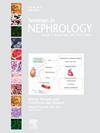求助PDF
{"title":"如何怀疑和处理遗传性小管病患者。","authors":"Fiona E Karet Frankl","doi":"10.1016/j.semnephrol.2025.151654","DOIUrl":null,"url":null,"abstract":"<p><p>Suspecting that a patient has an inherited renal tubular disorder usually involves a mixture of listening to their story, asking the right questions, looking at the whole patient and their context, examining components of blood and urine, and assessing relevant imaging. Usually, inherited tubulopathies are rare, and they may include extrarenal features. Genetic testing has become widely available and can be used to establish a firm diagnosis in many situations, but this should not replace attempts to work out the diagnosis biochemically. Patients with tubular disorders often wait a long time for a diagnosis because many such conditions are very rare; genetic confirmation may well improve their quality of life. Semin Nephrol 36:x-xx © 20XX Elsevier Inc. All rights reserved.</p>","PeriodicalId":21756,"journal":{"name":"Seminars in nephrology","volume":" ","pages":"151654"},"PeriodicalIF":3.5000,"publicationDate":"2025-07-01","publicationTypes":"Journal Article","fieldsOfStudy":null,"isOpenAccess":false,"openAccessPdf":"","citationCount":"0","resultStr":"{\"title\":\"How to Suspect and Approach Patients With Genetic Tubular Disease.\",\"authors\":\"Fiona E Karet Frankl\",\"doi\":\"10.1016/j.semnephrol.2025.151654\",\"DOIUrl\":null,\"url\":null,\"abstract\":\"<p><p>Suspecting that a patient has an inherited renal tubular disorder usually involves a mixture of listening to their story, asking the right questions, looking at the whole patient and their context, examining components of blood and urine, and assessing relevant imaging. Usually, inherited tubulopathies are rare, and they may include extrarenal features. Genetic testing has become widely available and can be used to establish a firm diagnosis in many situations, but this should not replace attempts to work out the diagnosis biochemically. Patients with tubular disorders often wait a long time for a diagnosis because many such conditions are very rare; genetic confirmation may well improve their quality of life. Semin Nephrol 36:x-xx © 20XX Elsevier Inc. All rights reserved.</p>\",\"PeriodicalId\":21756,\"journal\":{\"name\":\"Seminars in nephrology\",\"volume\":\" \",\"pages\":\"151654\"},\"PeriodicalIF\":3.5000,\"publicationDate\":\"2025-07-01\",\"publicationTypes\":\"Journal Article\",\"fieldsOfStudy\":null,\"isOpenAccess\":false,\"openAccessPdf\":\"\",\"citationCount\":\"0\",\"resultStr\":null,\"platform\":\"Semanticscholar\",\"paperid\":null,\"PeriodicalName\":\"Seminars in nephrology\",\"FirstCategoryId\":\"3\",\"ListUrlMain\":\"https://doi.org/10.1016/j.semnephrol.2025.151654\",\"RegionNum\":3,\"RegionCategory\":\"医学\",\"ArticlePicture\":[],\"TitleCN\":null,\"AbstractTextCN\":null,\"PMCID\":null,\"EPubDate\":\"2025/7/17 0:00:00\",\"PubModel\":\"Epub\",\"JCR\":\"Q2\",\"JCRName\":\"UROLOGY & NEPHROLOGY\",\"Score\":null,\"Total\":0}","platform":"Semanticscholar","paperid":null,"PeriodicalName":"Seminars in nephrology","FirstCategoryId":"3","ListUrlMain":"https://doi.org/10.1016/j.semnephrol.2025.151654","RegionNum":3,"RegionCategory":"医学","ArticlePicture":[],"TitleCN":null,"AbstractTextCN":null,"PMCID":null,"EPubDate":"2025/7/17 0:00:00","PubModel":"Epub","JCR":"Q2","JCRName":"UROLOGY & NEPHROLOGY","Score":null,"Total":0}
引用次数: 0
引用
批量引用

 求助内容:
求助内容: 应助结果提醒方式:
应助结果提醒方式:


